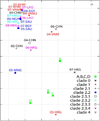Identifying antigenicity-associated sites in highly pathogenic H5N1 influenza virus hemagglutinin by using sparse learning
- PMID: 22609437
- PMCID: PMC3412944
- DOI: 10.1016/j.jmb.2012.05.011
Identifying antigenicity-associated sites in highly pathogenic H5N1 influenza virus hemagglutinin by using sparse learning
Abstract
Since the isolation of A/goose/Guangdong/1/1996 (H5N1) in farmed geese in southern China, highly pathogenic H5N1 avian influenza viruses have posed a continuous threat to both public and animal health. The non-synonymous mutation of the H5 hemagglutinin (HA) gene has resulted in antigenic drift, leading to difficulties in both clinical diagnosis and vaccine strain selection. Characterizing H5N1's antigenic profiles would help resolve these problems. In this study, a novel sparse learning method was developed to identify antigenicity-associated sites in influenza A viruses on the basis of immunologic data sets (i.e., from hemagglutination inhibition and microneutralization assays) and HA protein sequences. Twenty-one potential antigenicity-associated sites were identified. A total of 17 H5N1 mutants were used to validate the effects of 11 of these predicted sites on H5N1's antigenicity, including 7 newly identified sites not located in reported antibody binding sites. The experimental data confirmed that mutations of these tested sites lead to changes in viral antigenicity, validating our method.
Copyright © 2012 Elsevier Ltd. All rights reserved.
Figures






References
-
- Wan X-F. Master thesis. South China Agricultural University; 1998. Isolation and characterization of avian influenza viruses in China.
-
- Guo Y, Xu X, Wan X. [Genetic characterization of an avian influenza A (H5N1) virus isolated from a sick goose in China] Zhonghua Shi Yan He Lin Chuang Bing Du Xue Za Zhi. 1998;12:322–325. - PubMed
-
- Zhao ZM, Shortridge KF, Garcia M, Guan Y, Wan XF. Genotypic diversity of H5N1 highly pathogenic avian influenza viruses. J Gen Virol. 2008;89:2182–2193. - PubMed
Publication types
MeSH terms
Substances
Grants and funding
LinkOut - more resources
Full Text Sources

